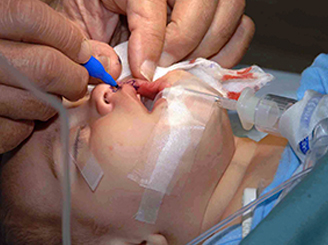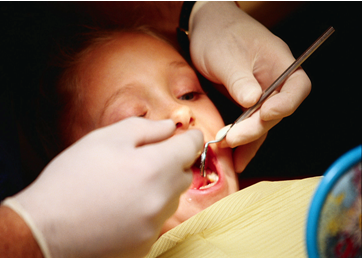In this section, the term cleft refers to a cleft lip, cleft palate or a cleft lip
and palate. Specific types of cleft are only referred to when necessary.
Cleft Clinics and Treatment Teams
Our aim is that all children born with a cleft should be able to go to a specialist
cleft clinic. Specialist cleft clinics are dedicated medical centres that provide
ongoing support to children and parents.
The cleft treatment team is made up of healthcare professionals from different specialist
backgrounds who work closely together. The team includes:
-
a specialist cleft nurse, who can provide initial advice about feeding and will
act as your first point of contact
- a cleft surgeon, who will carry out the repair of the cleft
- a speech and language therapist
-
an orthodontist, who specializes in straightening teeth with braces (an appliance
that is fitted in the mouth to help correct the position of the teeth)
- a pediatric (children's) or a general dentist
-
an audiologist and ear, nose and throat (ENT) surgeon, who assesses and treats hearing
conditions
- a psychologist, who has been trained in the scientific study of the mind
- a pediatrician, who specializes in treating children
Care Plan Timetable
Most children with clefts will receive the same type of care plan, which will be
tailored to meet their individual needs. A typical care plan timetable is described
below.
Once the initial care plan has been completed, the child will attend regular outpatient
appointments at the cleft clinic so that their condition can be closely monitored
and any problems dealt with.
Feeding
Many babies with a cleft palate have problems sucking through a nipple due to the
gap in the roof of their mouth.Some babies respond better to alternative feeding
methods than others.
One method that works well for some women is expressing breast milk into a specially
made flexible bottle and using the bottle for feeding.
Lip-repair Surgery
Lip-repair surgery is usually carried out when the child is three months old. The
child will be given a general anesthetic (put to sleep) and the cleft lip will be
carefully repaired, including the underlying muscles. The nose is usually reshaped
at the same time.
The operation usually takes about an hour, although it can take longer if the cleft
is particularly severe. The operation usually leaves a slight scar, but the surgeon
will attempt to line up the scar with the natural lines of the lip to make it less
noticeable.
Palate-repair Surgery
Palate-repair surgery is usually carried out when the child is six months of age.
The muscles and the lining of the palate are rearranged and usually no extra tissue
is needed to complete the operation.
The child will be given a general anaesthetic and the operation will usually take
about one-and-a-half hours. Again, the exact time will vary depending on how severe
the cleft is.
Additional Surgery
In some cases, additional surgery may be needed to improve the appearance and function
of the lips and mouth. For example, if there is a cleft in the gum, the surgeon
will perform a bone-graft operation when the child is between 9 and 12 years of
age.
Your cleft care team can tell you whether further surgery is required.
Hearing
Children with a cleft palate are more likely to develop a condition called glue
ear. The eustachian tube, which connects the back of the nose with the middle ear,
may not open and close properly due to the cleft palate.
This causes sticky secretions to build up in the middle ear, which can impair hearing.
If hearing is significantly reduced, the ENT surgeon may recommend treatment, such
as the insertion of a tiny plastic tube called a grommet into the eardrum. This
lets out the sticky secretions and allows air in. Sometimes, a hearing aid may be
recommended.
At birth, an audiologist (hearing specialist) will assess the child's hearing and
a second hearing assessment will take place once the child has had reconstructive
surgery. The child's hearing will also be regularly assessed during their outpatient
appointments.
Speech and Language Therapy
Surgery to repair a cleft palate will significantly reduce the chances of any future
speech problems occurring. However, approximately half of all children with a repaired
cleft palate will still need to have some form of speech therapy. The speech of
a small number of children will have a nasal tone and further corrective surgery
may be required.
A speech and language therapist will carry out an initial assessment after surgery,
followed by a further assessment once your child is three years old. If the assessment
reveals problems with the child's pronunciation and use of language, the Speech
therapist will teach the parents a number of speech exercises that can be used to
help their child's development. They may also carry out a number of one-to-one exercises
with the child.
The Speech therapist will work with the child for as long as they need assistance,
although therapy is not usually needed after the age of seven. In some cases, further
surgery may be needed to help improve the child's speech.
Dental Care
When the cleft involves the gum area, it is common for the teeth on either side
of the cleft to be tilted or out of position. Sometimes, a tooth may be missing
or there may be an extra tooth. The dentist will monitor the health of your child’s
teeth and recommend treatment when necessary. It is also important that you register
your child with a family dentist.
Orthodontic treatment, which helps improve the alignment and appearance of teeth,
may be required. Treatment may include using braces or other dental appliances to
help straighten the teeth.
Children with a cleft are more vulnerable to tooth decay, so it is important to
encourage them to practice good oral hyg.







